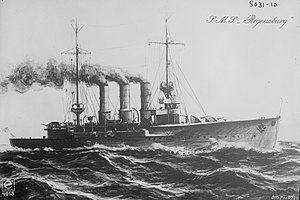
| |
| History | |
|---|---|
| Name | Graudenz |
| Namesake | City of Graudenz |
| Builder | Kiel Navy Yard |
| Laid down | 23 October 1912 |
| Launched | 25 October 1913 |
| Commissioned | 10 August 1914 |
| Stricken | 10 March 1920 |
| Fate | Ceded to Italy in 1920 |
| Name | Ancona |
| Namesake | City of Ancona |
| Acquired | 1 June 1920 |
| Stricken | 11 March 1937 |
| Fate | Scrapped |
| General characteristics | |
| Class and type | Graudenz-class cruiser |
| Displacement | |
| Length | 142.7 m (468 ft 2 in) |
| Beam | 13.8 m (45 ft 3 in) |
| Draft | 5.75 m (18 ft 10 in) |
| Installed power |
|
| Propulsion |
|
| Speed | 27.5 kn (50.9 km/h) |
| Range | 5,500 nmi (10,200 km; 6,300 mi) at 12 kn (22 km/h; 14 mph) |
| Crew |
|
| Armament |
|
| Armor |
|
SMS Graudenz was the lead ship of her class of light cruisers. She had one sister ship, SMS Regensburg. The ship was built by the German Kaiserliche Marine (Imperial Navy) in the Kaiserliche Werft shipyard in Kiel, laid down in 1912 and commissioned into the High Seas Fleet in August 1914, days after the outbreak of World War I. She was named for the then-German town of Graudenz (now Grudziądz, Poland). The ship was armed with a main battery of twelve 10.5 cm SK L/45 guns and had a top speed of 27.5 knots (50.9 km/h; 31.6 mph).
Graudenz saw extensive service during World War I, including serving as part of the reconnaissance screen for the battlecruisers of the I Scouting Group during the raid on Scarborough, Hartlepool and Whitby in December 1914. The ship also took part in the Battle of Dogger Bank in January 1915, and the Battle of the Gulf of Riga in August 1915. She had been damaged by a mine and was unable to participate in the Battle of Jutland in May 1916. She was assigned to the planned final operation of the High Seas Fleet in October 1918, weeks before the end of the war, but a major mutiny forced the cancellation of the plan. After the end of the war, the ship was ceded to Italy as a war prize and commissioned into the Italian Navy as Ancona; she remained in service until 1937 when she was stricken and broken up for scrap.